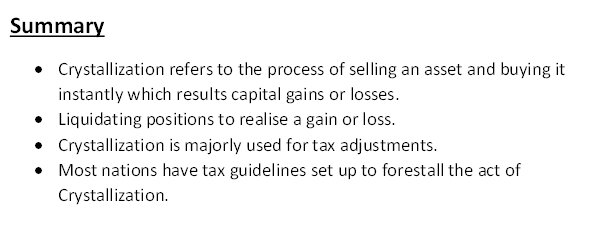What do you mean by Crystallization?
In the financial industry, Crystallization can be defined as selling of asset and then immediately buying the same asset back. This is done for tax purpose. Open positions incur a capital loss or gain, but these gains or losses are only realised when the positions are liquidated. Once the holdings are liquidated, investment tax regulations are applied accordingly.

Source: Copyright © 2021 Kalkine Media
Understanding Crystallisation
Crystallization is the term used when a dealer or an investor liquidates a position and afterward returns and reopens a position right away. In doing as such, they can adjust the net worth of their portfolio by balancing a shortfall or profit, without losing the position that they accept can, in any case, bring more service. Generally, this is accomplished for tax adjustment purposes, permitting a broker to understand a capital loss and pay any charges on it right away. Most nations have tax guidelines set up to forestall the act of Crystallization.
Crystallization of a position is helpful when expecting to understand a capital gain/loss for tax purposes, as required or prompted by an accountant or financial advisor, yet at the same time needing exposure to the market. The expense associated with utilising this methodology is the commission or spread that needs to be paid for reopening the position.
When an investor purchases a capital resource, an increment (or reduction) in the worth of the security doesn't always translate into a profit or loss. The investor can guarantee a benefit (or misfortune) after he has sold the stake. Selling the security at a profit is alluded to as crystallizing a capital gain.
For example, an investor buys 100 quantities of stock X at a price of £100. In a span of three months, the stock appreciates to £135. Until the investor does not liquidate his holding, he will not be able to crystallize the gain he has made. If he decides to sell his holding, his capital gain will be (£135 - £100) x 100 shares = £3,500. In this situation, he has crystallized £3500 capital gains.
In real estate deals, crystallization happens when a property, land or a house is sold. The same procedure is applicable to other material investments.
Frequently Asked Questions
What are the standard methods of Crystallization?
One method of Crystallization is exiting a position that is currently in a loss as the investor needs to take a capital loss but believes that the underlying asset will rise in the future. Thus, he would crystallize his loss by selling his loss and then repurchasing it straight away.
This methodology is significant for citizens who have holdings and made a capital increase. Under this procedure, a citizen with acknowledged gains would sell a portion of their holdings with unrealised losses to make those losses figured out.
These recognised losses will at that point be accessible to be counterbalanced against the capital increases, so the citizen's capital additions charge obligation is decreased or dispensed with.
If the citizen needs exposure to the underlying instrument to liquidate their losses, they can repurchase the offers once more. The net impact of this exchange is they have crystallized their capital losses and still have a holding in the stock, which they are confident about.
What are the pros and cons of Crystallization?
A coin has two sides; the same is with crystallization, it has both the pros and cons that include:
- The advantage is capital losses that have been crystallized can be conveyed forward uncertainly. The capital loss can be utilised to counterbalance acknowledged gains and reduce ordinary income in the resulting years. For instance, a financial investor who crystalizes £10,000 capital loss can apply this to his crystallized £3,000 capital gain. Since he will, in any case, have £7,000 subsequent to diminishing his capital increases tax to nothing, he can utilise something like £3,000 to lessen standard annual expense also.
For instance, if his yearly pay is £85,000, he may be burdened on £85,000 - £3,000 = £82,000.
The excess £4,000 in crystallized losses can be utilised similarly in the upcoming years.
- A disadvantage can be most countries have tax laws in place to regulate Crystallization.
For instance, in the US and Canada, an investor can't use a tax loss on the off chance that he repurchases the stock within 30 days of crystallizing from the equivalent shares.
 Please wait processing your request...
Please wait processing your request...